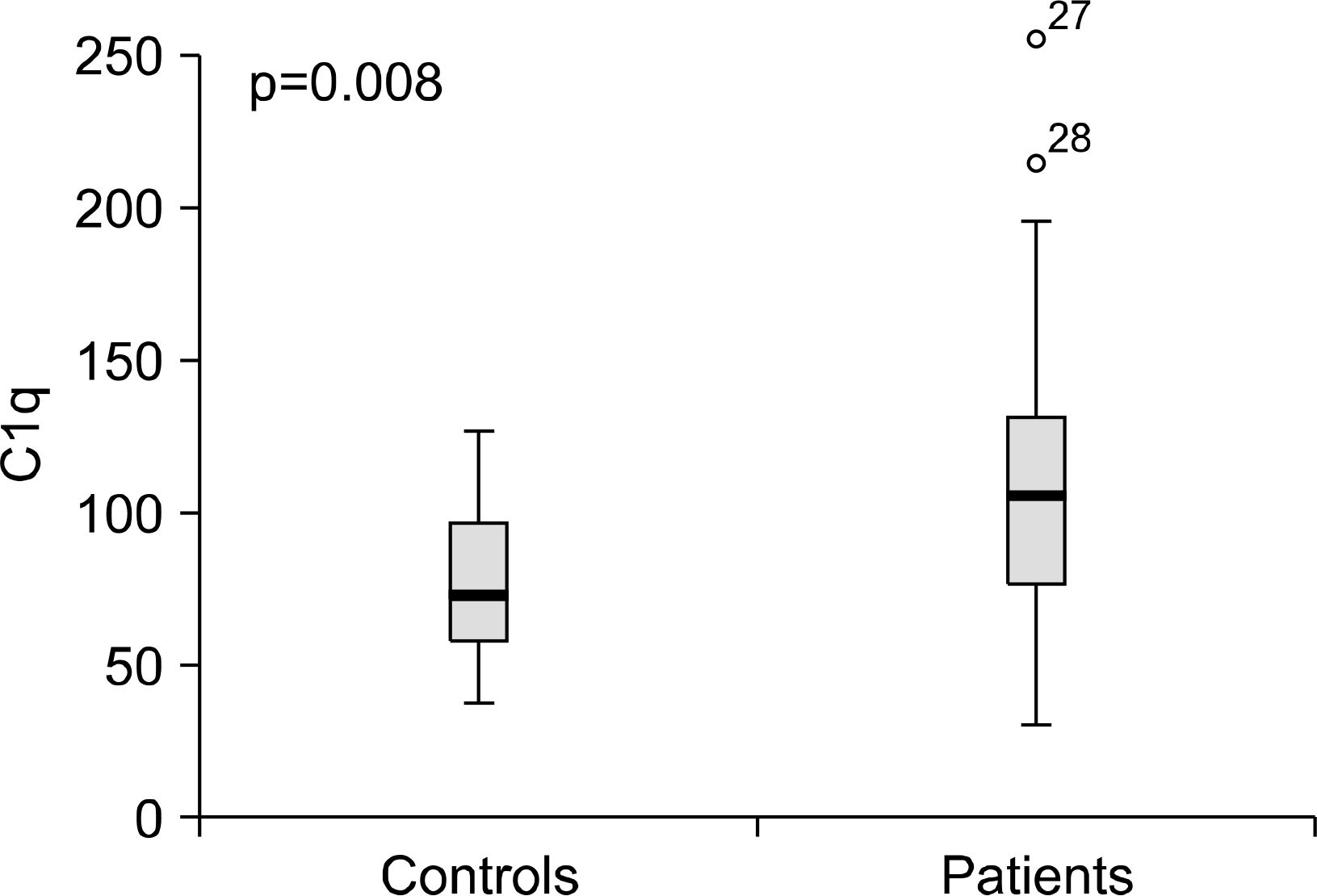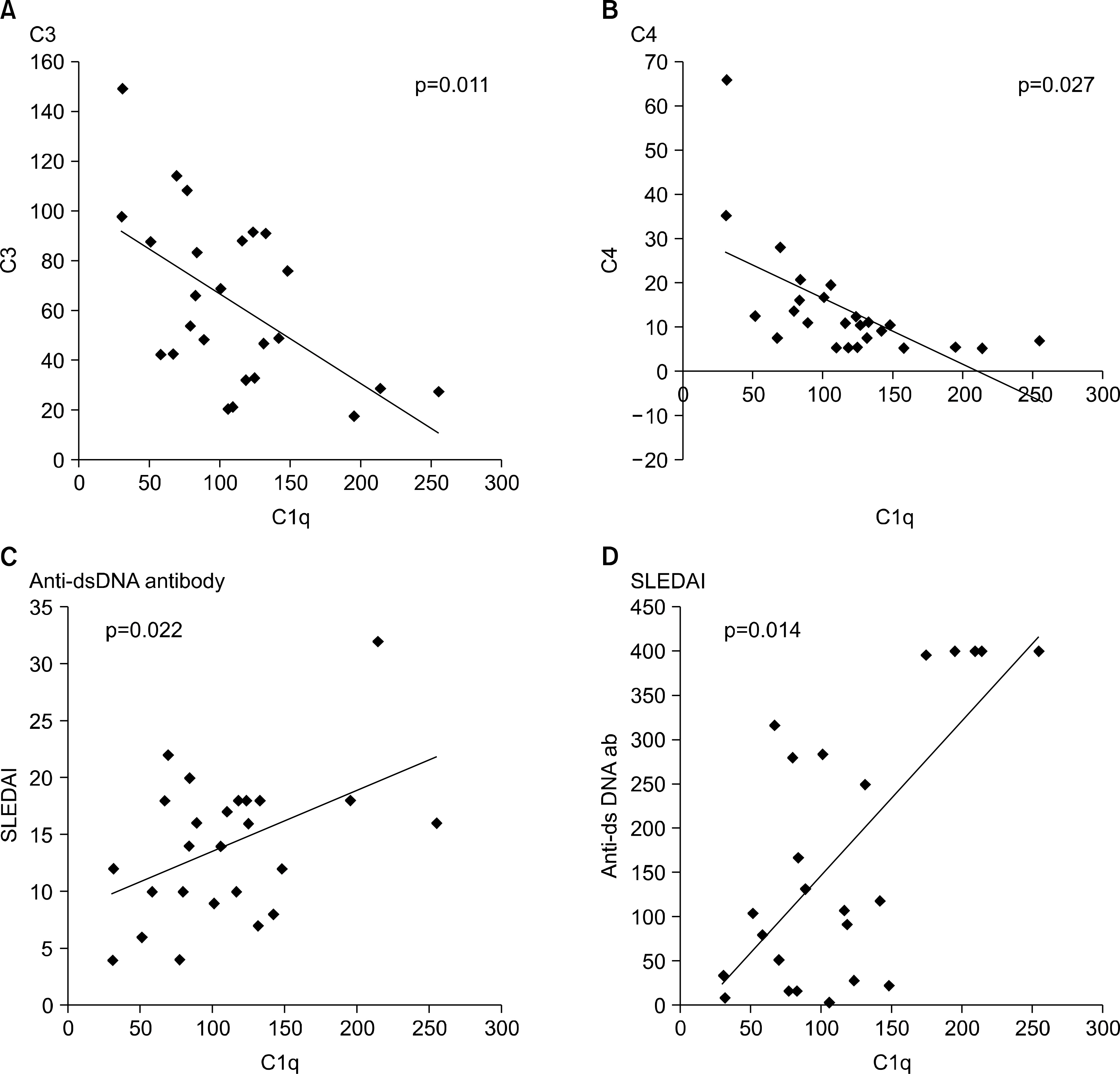J Korean Rheum Assoc.
2010 Dec;17(4):393-399. 10.4078/jkra.2010.17.4.393.
Clinical Significance of Serum C1q-Circulating Immune Complexes in Patients with Lupus Nephritis
- Affiliations
-
- 1Division of Rheumatology, Department of Internal Medicine, Keimyung University School of Medicine, Daegu, Korea. mdkim9111@dsmc.or.kr
- 2Division of Rheumatology, Department of Internal Medicine, Konkuk University School of Medicine, Seoul, Korea.
- 3Division of Rheumatology, Department of Internal Medicine, The Catholic University of Korea College of Medicine, Seoul, Korea.
- KMID: 2201897
- DOI: http://doi.org/10.4078/jkra.2010.17.4.393
Abstract
OBJECTIVE
The purpose of this study was to evaluate whether serum C1q-circulating immune complexes (C1q-CIC) serve as a predictive marker for renal flares in patients with lupus nephritis.
METHODS
Twenty-five patients with lupus nephritis and 24 healthy controls were enrolled. Patients with lupus nephritis had their serum C1q-CIC titers and other serologic parameters such as serum C3, C4, anti-dsDNA antibody, and erythrocyte sedimentation rate measured simultaneously. The systemic lupus erythematosus disease activity index (SLEDAI) was also checked.
RESULTS
Serum C1q-CIC titers were higher in patients with lupus nephritis than in healthy controls (109.33+/-53.79 microg/mL vs. 75.28+/-22.91 microg/mL, p=0.008). A statistically significant association was found between serum C1q-CIC titers and C3 (p=0.011), C4 (p=0.027), and anti-dsDNA antibody (p=0.014). SLEDAI was also correlated with serum C1q-CIC titers (p=0.022).
CONCLUSION
Serum C1q-CIC appears to be related to renal disease activity in patients with lupus nephritis. These results suggest that serum C1q-CIC is a predictive marker for renal flares in patients with lupus nephritis.
MeSH Terms
Figure
Reference
-
1). Austin HA 3rd., Klippel JH., Balow JE., le Riche NG., Steinberg AD., Plotz PH, et al. Therapy of lupus nephritis. Controlled trial of prednisone and cytotoxic drugs. N Engl J Med. 1986. 314:614–9.2). Steinberg AD., Steinberg SC. Long-term preservation of renal function in patients with lupus nephritis receiving treatment that includes cyclophosphamide versus those treated with prednisone only. Arthritis Rheum. 1991. 34:945–50.
Article3). Isenberg DA., Ravirajan CT., Rahman A., Kalsi J. The role of antibodies to DNA in systemic lupus erythematosus. A review and introduction to an international workshop on DNA antibodies held in London, May 1996. Lupus. 1997. 6:290–304.
Article4). Cameron JS., Turner DR., Ogg CS., Williams DG., Lessof MH., Chantler C, et al. Systemic lupus with nephritis: a long-term study. Q J Med. 1979. 48:1–24.5). Coremans IE., Spronk PE., Bootsma H., Daha MR., van der Voort EA., Kater L, et al. Changes in antibodies to C1q predict renal relapses in systemic lupus erythematosus. Am J Kidney Dis. 1995. 26:595–601.
Article6). Houssiau FA., D'Cruz D., Vianna J., Hughes GR. Lupus nephritis: the significance of serological tests at the time of biopsy. Clin Exp Rheumatol. 1991. 9:345–9.7). Navarro M., Cervera R., Font J., Reverter JC., Monteagudo J., Escolar G, et al. Anti-endothelial cell antibodies in systemic autoimmune diseases: Prevalence and clinical significance. Lupus. 1997. 6:521–6.8). D'Cruz DP., Houssiau FA., Ramirez G., Baguley E., McCutcheon J., Vianna J, et al. Antibodies to endothelial cells in systemic lupus erythematosus: a potential marker for nephritis and vasculitis. Clin Exp Immunol. 1991. 85:254–61.9). Johnson DW. Mycophenolate mofetil for treatment of refractory lupus nephritis. Intern Med J. 2001. 31:312.
Article10). Karassa FB., Isenberg DA. Efficacy of mycophenolate mofetil in patients with diffuse proliferative lupus nephritis. N Engl J Med. 2001. 344:382–3.
Article11). Adu D. The evidence base for the treatment of lupus nephritis in the new millennium. Nephrol Dial Transplant. 2001. 16:1536–8.
Article12). Lloyd W., Schur PH. Immune complexes, complement and anti-DNA in exacerbation of systemic lupus erythematosus (SLE). Medicine (Baltimore). 1981. 60:208–17.13). ter Borg EJ., Horst G., Hummel EJ., Limburg PC., Kallemberg CG. Measurement of increases in anti-double-stranded DNA antibody levels as a predictor of disease exacerbation in systemic lupus erythematosus. A long-term, prospective study. Arthritis Rheum. 1990. 33:634–43.14). Okamura M., Kanayama Y., Amastu K., Negoro N., Kohda S., Takeda T, et al. Significance of enzyme-linked immunosorbent assay (ELISA) for antibodies to double stranded and single stranded DNA in patients with lupus nephritis: Correlation with severity of renal histology. Ann Rheum Dis. 1993. 52:14–20.15). Swaak AJ., Aarden LA., Statius van Eps LW., Feltkamp TE. Anti-DNA and complement profiles as prognostic guides in systemic lupus erythematosus. Arthritis Rheum. 1979. 22:226–35.16). Siegert CE., Kazatchkine MD., SjoUholm A., WuUrzner R., Loos M., Daha MR. Autoantibodies against C1q: view on clinical relevance and pathogenic roles. Clin Exp Immunol. 1999. 116:4–8.
Article17). Uwatoko S., Aotsuka S., Okawa M., Egusa Y., Yokohari R., Aizawa C, et al. Characterization of C1q-binding IgG complexes in systemic lupus erythematosus. Clin Immunol Immunopathol. 1984. 30:104–16.
Article18). Moroni G., Trendelenburg M., Del Papa N., Quaglini S., Raschi E., Panzeri P, et al. Anti-C1q Antibodies May Help in Diagnosing a Renal Flare in Lupus Nephritis. Am J Kidney Dis. 2001. 37:490–8.
Article19). Mosca M., Chimenti D., Pratesi F., Baldini C., Anzilotti C., Bombardieri S, et al. Prevalence and Clinicoserological Correlations of anti-aL-endolase, anti-C1q, and anti-dsDNA antibodies in patients with SLE. J Rheumatol. 2006. 33:695–7.20). Sabbatini A., Dolcher MP., Marchini B., Chimenti D., Moscato S., Pratesi F, et al. Alpha-endolase is a renal-specific antigen associated with kidney involvement in mixed cryoglobulinemia. Clin Exp Rheumatol. 1997. 15:655–8.21). Carvalho D., Savage CO., Isenberg D., Pearson JD. IgG anti-endothelial cell autoantibodies from patients with systemic lupus erythematosus or systemic vasculitis stimulate the release of two endothelial cell-derived mediators which enhance adhesion molecule expression and leukocyte adhesion in an autocrine manner. Arthritis Rheum. 1999. 42:631–40.
Article22). Papa ND., Raschi E., Moroni G., Panzeri P., Borghi MO., Ponticelli C, et al. Anti-endothelial cell IgG fractions from systemic lupus erythematosus patients bind to human endothelial cells and induce a pro-adhesive and a pro-inflammatory phenotype in vitro. Lupus. 1999. 8:423–9.
- Full Text Links
- Actions
-
Cited
- CITED
-
- Close
- Share
- Similar articles
-
- Immediate Effects of Methylprednisolone Pulse Therapy on the Immune Response
- A Study on Circulating Immune Complexes in Leprosy Sera
- A case of Lupus Nephritis
- Complete Remission from C1q Nephropathy with Disappearance of C1q Deposition after Steroid Therapy
- Histologic evaluation of activity and chronicity of lupus nephritis and its clinical significance



